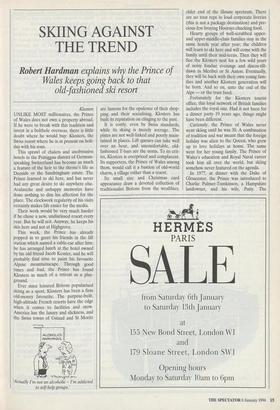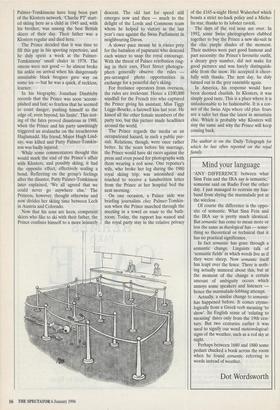SKIING AGAINST THE TREND
Robert Hardman explains why the Prince of
Wales keeps going back to that old-fashioned ski resort
Klosters UNLIKE MOST millionaires, the Prince of Wales does not own a property abroad. If he were to break with this tradition and invest in a bolthole overseas, there is little doubt where he would buy: Klosters, the Swiss resort where he is at present on holi- day with his sons.
This sprawl of chalets and unobtrusive hotels in the Pratiggau district of German- speaking Switzerland has become as much a feature of the heir to the throne's life as Deeside or the Sandringham estate. The Prince learned to ski here, and has never had any great desire to ski anywhere else. Avalanche and unhappy memories have done nothing to dim his affection for the place. The clockwork regularity of his visits certainly makes life easier for the media.
Their work would be very much harder if he chose a new, undisclosed resort every year. But he will not. Anyway, he keeps his skis here and not at Highgrove.
This week, the Prince has already popped in to greet his friends in the lift station which named a cable-car after him; he has arranged lunch at the hotel owned by his old friend Jacob Kessler, and he will probably find time to paint his favourite Alpine mountainscape. Through good times and bad, the Prince has found Klosters as much of a retreat as a play- ground.
Ever since leisured Britons popularised skiing as a sport, Klosters has been a firm old-money favourite. The purpose-built, high-altitude French resorts have the edge when it comes to facilities and snow. America has the luxury and slickness, and the Swiss towns of Gstaad and St Moritz Actually I'm not an alcoholic - I'm addicted to self-help groups.' are famous for the opulence of their shop- ping and their socialising. Klosters has built its reputation on clinging to the past.
It is costly, even by Swiss standards, while its skiing is merely average. The pistes are not well-linked and poorly main- tained in places. Lift queues can take well over an hour, and uncomfortable, old- fashioned T-bars are the norm. To its crit- ics, Klosters is overpriced and complacent. Its supporters, the Prince of Wales among them, would call it a bastion of old-world charm, a village rather than a resort.
Its small size and Christmas card appearance draw a devoted collection of traditionalist Britons from the wealthier, older end of the Sloane spectrum. There are no tour reps in loud corporate liveries (this is not a package destination) and pre- cious few braying Hoorays chucking food.
Hearty groups of well-scrubbed upper- and upper-middle-class families stay in the same hotels year after year; the children will learn to ski here and will come with the family until their mid-teens. Then they will flee the Klosters nest for a few wild years of noisy fondue evenings and discos-till- dawn in Meribel or St Anton. Eventually, they will be back with their own young fam- ilies and another Klosters generation will be born. And so on, unto the end of the Alps — or the trust fund.
Fortunately for the Klosters tourist office, this loyal network of British families includes the royal one. Had it not been for a dinner party 19 years ago, things might have been different.
Curiously, the Prince of Wales never went skiing until he was 30. A combination of tradition and war meant that the foreign holiday was alien to the Queen, who grew up to love holidays at home. The same went for her young family. The Prince of Wales's education and Royal Naval career took him all over the world, but skiing somehow never featured on the agenda.
In 1977, at dinner with the Duke of Gloucester, the Prince was introduced to Charlie Palmer-Tomkinson, a Hampshire landowner, and his wife, Patty. The Palmer-Tomkinsons have long been part of the Klosters network. 'Charlie PT' start- ed skiing here as a child in 1945 and, with his brother, was among the best British skiers of their day. Their father was a Klosters regular and died here.
The Prince decided that it was time to fill this gap in his sporting repertoire, and he duly spent a week at the Palmer- Tomkinsons' small chalet in 1978. The omens were not good — he almost broke his ankle on arrival when his dangerously unsuitable black brogues gave way on some ice — but he was a quick, if reckless, learner.
In his biography, Jonathan Dimbleby records that the Prince was soon 'accom- plished and fast; so fearless that he seemed to court danger, pushing himself to the edge of, even beyond, his limits'. This test- ing of the fates proved disastrous in 1988, when the Prince and his party unwittingly triggered an avalanche on the treacherous Haglamadd. His friend, Major Hugh Lind- say, was killed and Patty Palmer-Tomkin- son was badly injured.
While some commentators thought this would mark the end of the Prince's affair with Klosters, and possibly skiing, it had the opposite effect, effectively sealing a bond. Reflecting on the group's feelings after the disaster, Patty Palmer-Tomkinson later explained, 'We all agreed that we could never go anywhere else.' The Princess, however, thought otherwise and now divides her skiing time between Lech in Austria and Colorado.
Now that his sons are keen, competent skiers who like to ski with their father, the Prince confines himself to a more leisurely descent. The old lust for speed still emerges now and then — much to the delight of the Lords and Commons team whom he helped to victory in the last year's race against the Swiss Parliament in neighbouring Davos.
A slower pace means he is easier prey for the battalion of paparazzi who descend each winter to snap the royal entourage. With the threat of Palace retribution ring- ing in their ears, Fleet Street photogra- phers generally observe the rules pre-arranged photo opportunities in exchange for a peaceful day's skiing.
For freelance operators from overseas, the rules are irrelevant. Hence a £100,000 windfall for the French trio who captured the Prince giving his assistant, Miss Tiggy Legge-Bourke, a farewell kiss last year. He kissed all the other female members of the party too, but this picture made headlines around the world.
The Prince regards the media as an occupational hazard, in such a public pur- suit. Relations, though, were once rather better. In the years before his marriage, the Prince would have ski races against the press and even posed for photographs with them wearing a red nose. One reporter's wife, who broke her leg during the 1980 royal skiing trip, was astonished and touched to receive a handwritten letter from the Prince at her hospital bed the next morning.
On one occasion, a Palace aide was briefing journalists chez Palmer-Tomkin- son when the Prince marched through the meeting in a towel en route to the bath- room. Today, the rapport has waned and the royal party stay in the relative privacy of the £165-a-night Hotel Walserhof which boasts a strict no-hack policy and a Miche- lin star, thanks to its lobster ravioli.
The days of the red nose are over. In 1992, some Swiss photographers clubbed together to buy the Prince a new ski-suit in the chic purple shades of the moment. Their motives were part good humour and part necessity: the Prince's favourite outfit, a dreary grey number, did not make for good pictures and was barely distinguish- able from the snow. He accepted it cheer- fully with thanks. The next day, he duly turned out in the grey ensemble again.
In America, his response would have been deemed churlish. In Klosters, it was simply good taste. This is a place where it is unfashionable to be fashionable. It is a cor- ner of the Swiss Alps where old plus- fours are a safer bet than the latest in mountain chic. Which is probably why Klosters will stay the same and why the Prince will keep coming back.
The author is on the Daily Telegraph for which he has often reported on the royal family.



















































 Previous page
Previous page